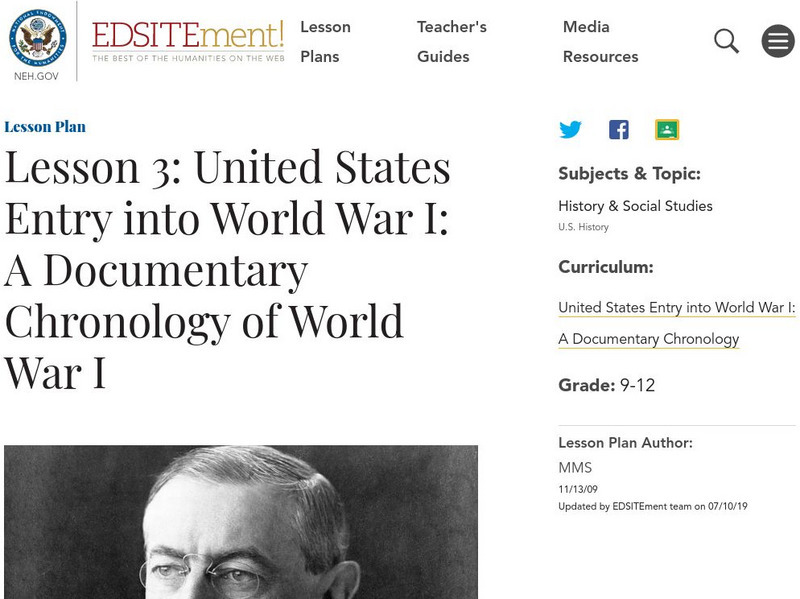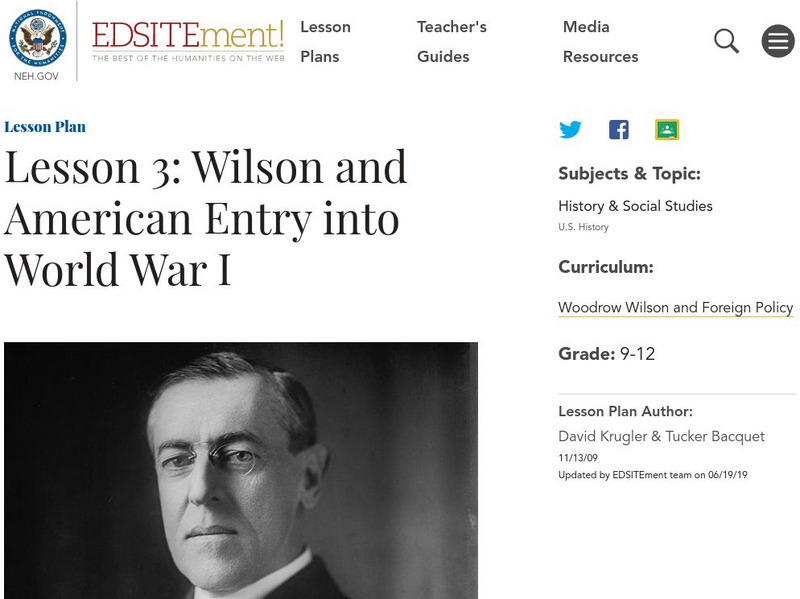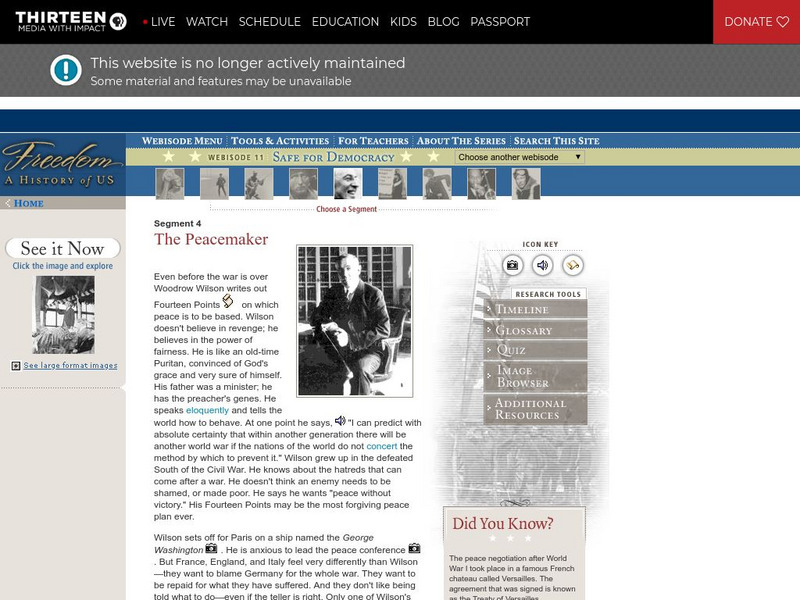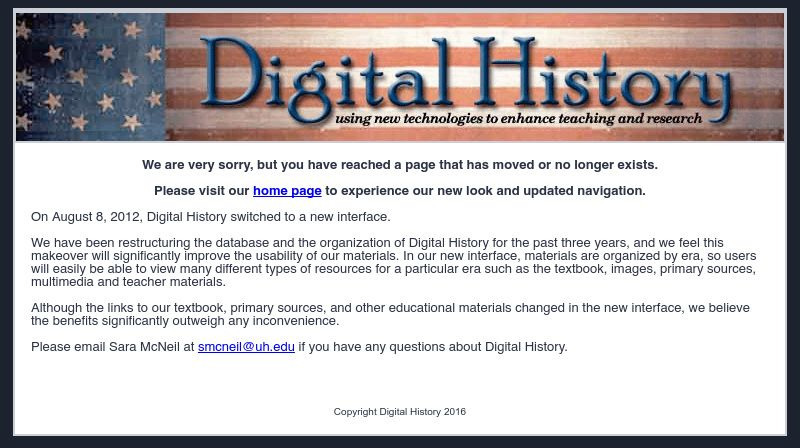Curated OER
Wilson's 14 Points
Students analyze political cartoons representing the role of the U.S. in the Post-World War One Era. They work in groups and analyze cartoons for their stereotypes, symbols, and caricatures. After analyzing them, they complete a...
Curated OER
President Woodrow Wilson's Fourteen Points
Ninth graders evaluate President Woodrow Wilson's principle of self-determination and its effects today. In groups, they research how the Great Powers dealt with Korea at the Paris Peace Conference and compare their perspectives with...
National Endowment for the Humanities
Neh: Edsit Ement: u.s. Entry Into World War 1: Curriculum Unit
A teacher-directed curriculum unit that deals with the issue of why the United States entered World war 1. Includes an extensive list of additional resources and activities.
National Endowment for the Humanities
Neh: Edsit Ement: Woodrow Wilson and American Entry Into Ww I
This lesson plan explores the ways President Woodrow Wilson tried to keep America out of war as World War I raged in Europe. Examine documents, speeches, and other primary sources to follow America's path from neutrality to war.
Library of Congress
Loc: American Memory: Tactics and Techniques of the National Woman's Party [Pdf]
This comprehensive essay lays out the tactics the National Woman's Party used in its campaign to obtain women's suffrage. In addition to an explanation of the various tactics are many photographs from the Library of Congress' Records of...
American Presidency Project
American Presidency Project: Wilson's Proclamation Establishing Conscription
Find the text of the presidential proclamation which established the draft in World War I. President Wilson signed this proclamation on May 18, 1917.
OpenStax
Open Stax: Progressive Movement: New Voices for Women and African Americans
Examines how the women's rights movement began and how it evolved over time, followed by a look at the development of the African American civil rights movement and the different leaders that emerged during the Progressive Era.
PBS
Wnet: Thirteen: Freedom: A History of Us: The Peacemaker
Find a document containing President Wilson's plan for peace after World War I, known as his Fourteen Points, as well as photographs with captions, and the audio of one of his speeches in which he lays out his ideas and garners support...
PBS
Pbs Learning Media: Primary Source Set: World War I: America Heads to War
This collection uses primary sources to explore America's entry into World War I.
Khan Academy
Khan Academy: Woodrow Wilson's Fourteen Points
The study resource from Khan Academy provides a video lesson for Period 7: 1890-1945 in American History. This lesson discusses President Woodrow Wilson's Fourteen Points. This resource is designed as a review for the AP US History Test.
Khan Academy
Khan Academy: Ap Us History: Period 1890 1945: Presidency of Woodrow Wilson
The study resource from Khan Academy provides an informational article over Period 7: 1890-1945 in American History. The Presidency of Woodrow Wilson is discussed in this lesson. This resource is designed as a review for the AP US...
Khan Academy
Khan Academy: Ap Us History/college History: United States Enters World War I
The study resource from Khan Academy provides a video for Period 7: 1890-1945 in American History. This section discusses America's entry into World War I. This resource is designed as a review for the AP US History Test.
Khan Academy
Khan Academy: Ap Us History/college History Unit: Period 7: 1890 1945
The study resource from Khan Academy provides a video lesson about the Zimmerman Telegram: Period 7: 1890-1945 in American History. This resource is designed as a review for the AP US History Test.
Digital History
Digital History: Espionage and Sedition Acts
Suspension of civil liberties by the government is always a radial act. Read about why President Wilson and the Congress thought this was necessary upon the U.S. entrance to World War I, and see who really suffered from the enforcement...
Digital History
Digital History: Woodrow Wilson and the League of Nations [Pdf]
President Woodrow Wilson had great hopes that a League of Nations would mean that there would be no more world wars. Read about the charter for the League of Nations, especially Article X, which provided the teeth for the organization....
Digital History
Digital History: Neutrality and the Lusitania [Pdf]
American neutrality in World War I was sorely tested with the attack and sinking of the passenger ship, Luisitania. Read information about the attack and find conflicting reactions by Franklin Roosevelt and William Jennings Bryan about...
Digital History
Digital History: America Goes to War [Pdf]
President Woodrow Wilson tried to maintain American neutrality in World War I. Find out why he decided that the U.S. needed to join the war and read a portion of his message to Congress asking for a declaration of war against Germany....
Digital History
Digital History: The Fourteen Points and the Versailles Treaty [Pdf]
President Woodrow Wilson, in his hope that World War I was the war to end all wars, issued his Fourteen Points almost one year before the end of the war as a bluepoint to guarantee peace across the world. Read a summary of the points and...
Digital History
Digital History: The Rise of the Dictators [Pdf]
Use this lesson plan to explore the economic and political conditions in Europe after World War I as a result of the Treaty of Versailles that led to the rise of dictators in several countries. Read about the rise of Lenin and Stalin in...
Other
Wwi Resource Centre:the Politics of Pecuniary Aggrandizement: 1912 1920
A chapter from a 1937 book by Ferdinand Ludnberg, America's 60 Families, discusses how World War I was financed and who profited from the war. About halfway through the page is mention of the War Industries Board and the heads of...
PBS
American Experience: Espionage and Sedition Acts
As progressive a president as Woodrow Wilson was, when the U.S. joined World War I, he signed legislation that made it a crime to criticize the government. Read about the espionage and sedition acts that were passed and how they were...
American Rhetoric
American Rhetoric: Woodrow Wilson: Final Speech in Support of League of Nations
This is the text of President Woodrow Wilson's last speech in support of the League of Nations delivered on September 25, 1919, in Pueblo, Colorado.
American Rhetoric
American Rhetoric: Woodrow Wilson: First Inaugural Address
This is the text of President Woodrow Wilson's First Inaugural Address delivered on April 4, 1913.
Digital History
Digital History: The United States Wwi
This site explains how Germany resuming unrestricted submarine warfare contributed to the US entering WWI. Site is well-written, informative, and contains great details.






![Loc: American Memory: Tactics and Techniques of the National Woman's Party [Pdf] Website Loc: American Memory: Tactics and Techniques of the National Woman's Party [Pdf] Website](http://content.lessonplanet.com/resources/thumbnails/409988/large/bwluav9tywdpy2symdiwmduymc0xndu1mi0xywq0bjlplmpwzw.jpg?1589982863)










